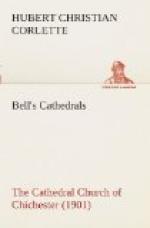of S. Richard. In many old prints its character
is represented, and Dallaway gives some dimensions
of it in the long section he shows of the church as
it was before the reredos was removed (see page 2).
The feretory no doubt had a reredos at this point,
but what the type of this earlier arrangement may have
been it is impossible exactly to tell. But the
work which took its place was evidently beautiful,
as the many remains still in existence prove to those
who may examine them. Walcott [11] gives some
interesting details concerning this work. From
the representations, descriptions, and remains of
it, it may be gathered that the whole was much carved,
niched, and canopied, and decorated in colour; and
there is a note extant showing that Lambert Bernardi
in the sixteenth century repaired “the painted
cloth of the crucifix over the high altar.” [12]
This reredos had a gallery across the top of it, from
which the candles on a beam over the altar could be
lighted and a watch kept over the precious jewels
in S. Richard’s shrine. The whole screen
was made of oak, and those old sketches and drawings,
or prints, of it still preserved, help dimly to show
what had been its character. An old letter in
the British Museum refers to it as having the finest
“glory” above the high altar “we
have ever seen.” But this so-called “glory”
was an eighteenth-century production. Much of
the reredos is still hidden away unused in the chamber
over the present library of the church, and since
its first removal it has travelled as far as London
in search of a friendly purchaser. In the chapter
on Chichester in Winkles’s “Cathedrals”
a view in the “presbytery,” dated 1836,
[13] shows the reredos still in its place where it
remained till after the fall of the spire. There
are in existence two drawings of considerable interest.
[14] One of these shows the east end and the other
the west end of the choir as it was about the beginning
of the last century (c. 1818); the other indicates
what were the changes made after 1829, when the altar
was set back six feet farther eastward. The latter
was taken from a water-colour drawing supposed to
have been made by Carter, an architect of Winchester.
[10] Walcott, p. 16. [11] “Early
Statutes.” [12] Walcott, p. 23, note a.
[13] See page 45. [14] See drawings in vestry
of cathedral.
Other minor works were added during the fourteenth
century, but to few of these can any exact dates be
assigned. The parapets to the north and south
wall of the nave, the choir, and lady-chapel, and the
painted oak choir-stalls were some of those additions.
In the fourteenth century we meet many changes in
the treatment of the windows. They became larger;
they were themselves very treasuries of design, and
this not only for the stonework of their tracery, but
also for the very beautiful glass with which they
had been filled. Their outer arches are more
varied in shape, more rich in moulded detail, and
the entire character of the curves of the moulded forms
had been developed and made more delicate than the
stronger and deeper-cut types from which they were
derived. Two causes had apparently urged the
builders to exert their capacities and apply their
increasing technical skill to compass the aims proposed
to them.




